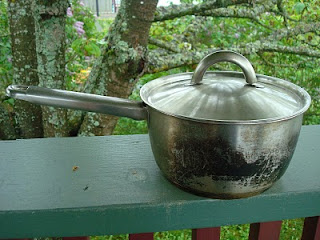Step 1 - Find some clean fresh water. Those of us who live in urban areas will often find it lurking in faucets or hoses, while rural water usually hides out in lakes, rivers and glaciers. Should you happen to live in a very dry place you may need to use a dowsing rod.
Step 2 - Pour the water into a heating vessel. A stove-top kettle or an electric kettle is preferred, but a metal cooking pan (MCP) will work in a pinch.
Exhibit C - One totally awesome tea kettle!
Step 3 - If you're using a stove-top kettle or a MCP, put it on a burner and turn the heat to its highest setting. If you are using an electric kettle, follow the manufacturer's recommendations for turning it on (usually there is some sort of switch manipulation involved).
WARNING: Do not let your out-of-town guests accidentally put your electric kettle on a hot stove-top burner as this will result in melting plastic and toxic fumes which are generally considered bad for tea making.
Step 4 - Wait. In my opinion, this is the easiest of the five steps. You can use this down time to catch up on some other tea making steps, use the bathroom, or just zone out. Feel free to watch the pot if you want to, because numerous experiments have proven that, contrary to some household myths, "pot watching" does not effect boiling.
Step 5 - Turn the heat off when the water starts boiling. Some kettles will whistle when this happens, but if yours does not, or if you are using a MCP, the vessel will also shake, rattle and produce lots of steam. The water inside it will look hot and bubbly. All of these are good signs that your water is now boiling! Electric kettles, on the other hand, will turn themselves off when they have reached boiling. That moment is often accompanied by a satisfying little "click" sound.
Exhibit F - Mission Accomplished!









3 comments:
People often laugh when they come over and I make them tea, because I do not own a tea kettle. They're like--but you're a tea fanatic, you are constantly giving me samples of loose tea and you run a tea website and you're always talking about tea.
I like the metal cooking pot for several reasons, but the main reason is ease of cleaning. Tea kettles need to be cleaned--especially in areas where there is some sort of mineral accumulation in the water. I've found that even if you rinse the teapot after each use, it still accumulates minerals. This will spoil the flavor of the tea over time. While there are ways to clean a tea kettle by putting something in them that will dissolve the minerals, it's so much easier to clean a basic stainless steel pot. I've found it just makes my life a lot easier in the long-run. Plus, I then have one fewer large item in my kitchen.
The one thing I miss about this phase of making tea, however, is the gas stove from my last apartment. It made it so easy to get the exact temperature I wanted, and quickly. Now, with my electric stove, I have to be more vigilant in watching, and it takes longer for it to heat up too.
Not only are toxic fumes bad for the tea, they're not reccommended for humans either. I am moving from an electric stove to a gas and I am sooooo happy. Not only can you boil water better with it, but you can cook and bake your goodies better.Yay!
What about those of us at high elevations? Also, my water comes out of the fridge; is this going to effect the outcome?
-Thirsty in Nevada
Post a Comment